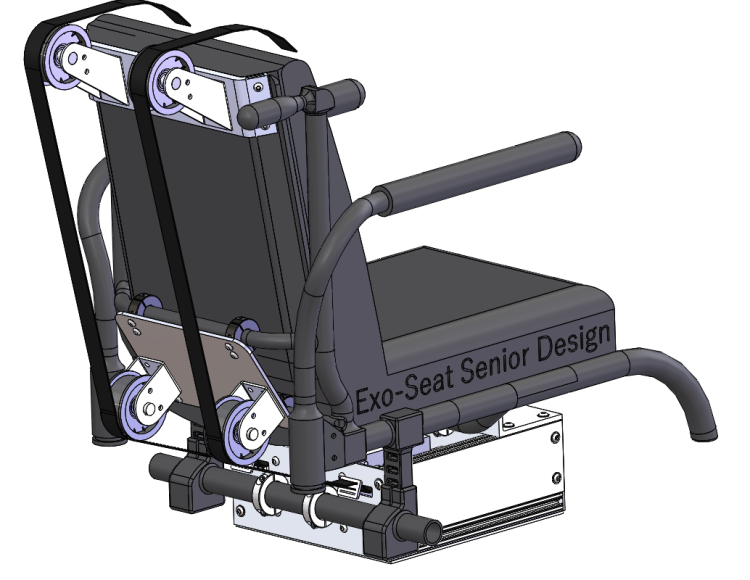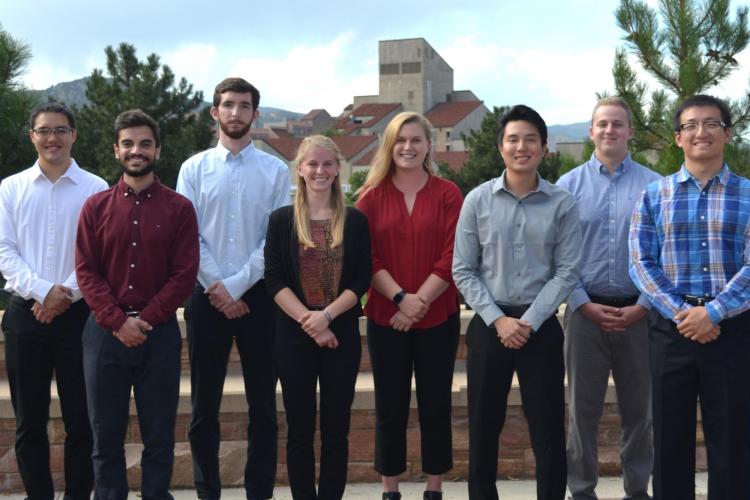Capstone Design Q&A: Improving quality of life for those with multiple sclerosis

The Exo-Seat attaches to a wheelchair and is designed to provide postural support and assist upper-body movement for those with multiple sclerosis.
Engineering seniors and graduate students put their skills to the test through capstone design projects. In most cases, mechanical engineering teams are sponsored by industry partners or pitch their ideas to investors. Follow capstone design teams through our series of Capstone Design Q&As to learn how students are using engineering to solve real-world problems.

Team members from left to right: Adam Smrekar, Mohammed Hussam Alsheikh, Eddie Herrick-Reynolds, Sonya Schuppan, Morgan Kauss, Brandon Lewien, Matt Human, Guanxiong Fu
What problem does your project solve?
The Exo-Seat is a motorized wheelchair attachment that provides postural support and assists upper-body movement for Cindy, a woman in the community who struggles with fatigue and muscle degeneration due to secondary progressive multiple sclerosis. Given her condition, she is often unable to hold her upper-body upright in her wheelchair, forcing her into uncomfortable and painful positions that severely compromise her respiratory functions. With our device, we hope to improve her independence and quality of life by empowering her to move freely and maintain a healthy posture without the need of constant assistance from caregivers.
Who is your project sponsor?
Tensentric, a local medical device and in-vitro diagnostic systems contracting company is our pro-bono sponsor for this project. They have been providing us with medical device engineering mentorship and financial support.
What have you and your capstone design team accomplished that you are proud of?
Nothing is more important to us than providing Cindy with a device that will improve her current situation and quality of life. After demoing our working device, Cindy and her caregivers described the Exo-Seat as "life-changing" for her. We are incredibly grateful and proud to be putting what we have learned as engineering students over the past four years to use on a product that will have a direct and lasting impact on another individual’s life.
We are also proud to have worked together on an interdisciplinary team of mechanical and electrical engineering students, learning how to navigate technical communication between separate disciplines and how to work together to integrate mechanical and electrical subsystems.
What have you learned from this project?
Working with Tensentric on this project, we've learned many factors that go into the design of a medical device including risk analysis, safety testing, design requirements, user needs documentation and human factors engineering considerations. Thinking through scenarios of how the end user will use our product was key to developing a safe, easy-to-use and beneficial product in the end.
What are you most excited to share about your project?
We are excited to share the work that we have done to better the life of a member of our community. We hope to inspire more engineers to utilize their knowledge to help those less fortunate than them.
What advice do you have for future capstone design teams?
This is an incredible opportunity to build something that you can be really proud of, so take ownership of your project and give it your best effort. You won’t regret it!

